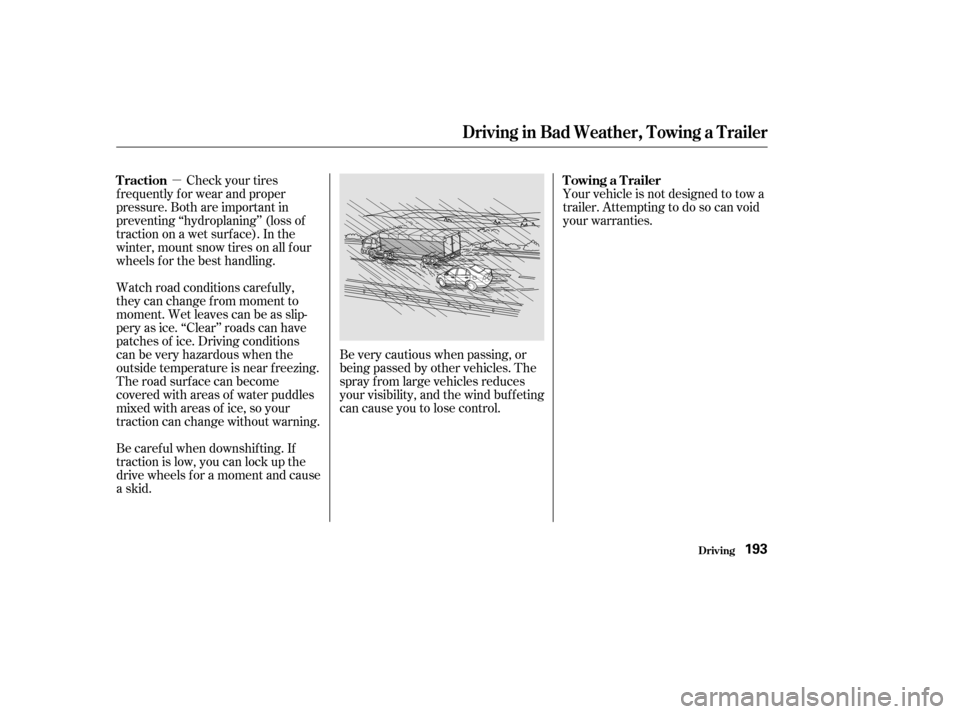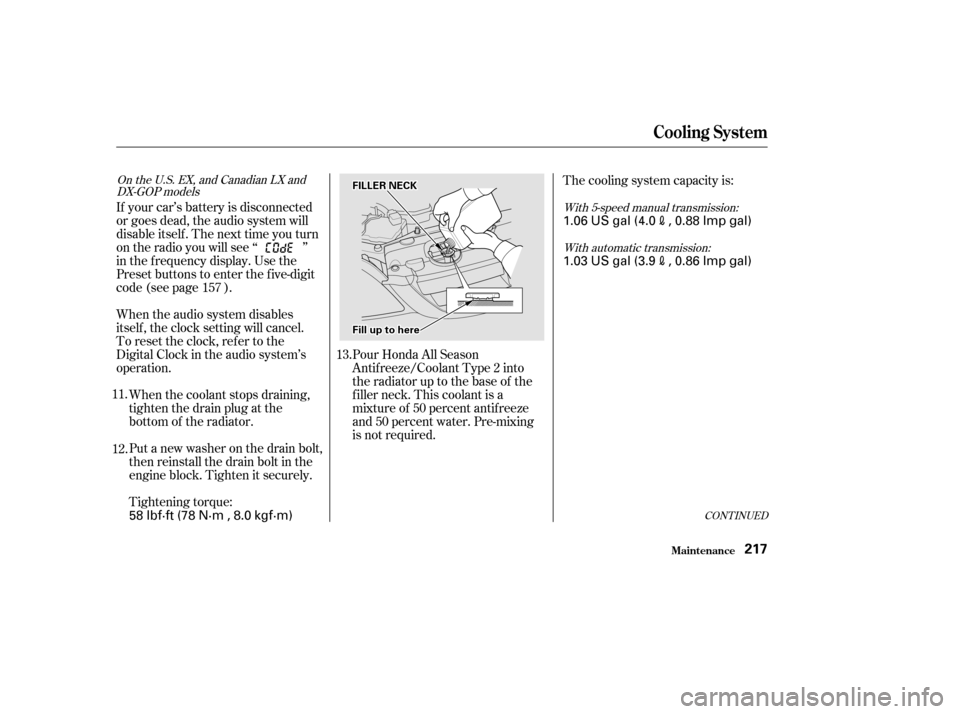Page 192 of 321

�µCheck your tires
f requently f or wear and proper
pressure. Both are important in
preventing ‘‘hydroplaning’’ (loss of
traction on a wet surface). In the
winter, mount snow tires on all f our
wheels f or the best handling.
Watch road conditions caref ully,
they can change f rom moment to
moment. Wet leaves can be as slip-
pery as ice. ‘‘Clear’’ roads can have
patches of ice. Driving conditions
can be very hazardous when the
outside temperature is near f reezing.
The road surf ace can become
covered with areas of water puddles
mixed with areas of ice, so your
traction can change without warning.
Be caref ul when downshif ting. If
traction is low, you can lock up the
drive wheels f or a moment and cause
askid. Be very cautious when passing, or
beingpassedbyothervehicles.The
spray f rom large vehicles reduces
your visibility, and the wind buf f eting
can cause you to lose control.Your vehicle is not designed to tow a
trailer. Attempting to do so can void
your warranties.
Driving in Bad Weather, Towing a Trailer
Driving
Towing a Trailer
Traction
193
Page 201 of 321

�µ
�Î �Î�Ì�Ì�Ì
�Î
�Ì�Î
Maint enance202
Service at the indicated distance or time whichever comes first. miles x 1,000
km x 1,000
months
Replace every 5,000 miles (8,000 km) or 6 monthsCheck oil and coolant at each fuel stop
1016
508070
112 110176
Check engine oil and coolant
Replace engine oil
Rotate tires (Check tire inflation and condition at least once per month)
Replace engine oil filter
Inspect front and rear brakes
Lubricate all hinges, locks, and latches
Visually inspect the following items: Tie rod ends, steering gear box and boots
Suspension components
Driveshaft boots
Check parking brake adjustment
Visually inspect the following items: Brake hoses and lines (including ABS)
All fluid levels and condition of fluidsExhaust system, Fuel lines and connections
Lights and controls, Vehicle underbody
Inspect and adjust drive belts
Replace dust and pollen filter
Replace transmission fluid
Replace air cleaner element
Replace spark plugs
Inspect valve clearance
Replace timing belt , and inspect water pump
Inspect idle speed
Replace engine coolant
Replace brake fluid
See information on maintenance and emissions warranty, last column, page .
See Timing Belt on page for replacement information under special driving conditions.
See Dust and Pollen Filter on page for replacement information under special driving conditions. At 120,000 miles (192,000 km) or 10 years,
then every 60,000 miles (96,000 km) or 5 years Every 3 years (independent of mileage)
Every 110,000 miles (176,000 km) or 7 years
Inspect every 110,000 miles (176,000 km), otherwise adjust only if noisy Every 110,000 miles (176,000 km)
Every 15,000 miles (24,000 km) in dusty conditions,
otherwise use normal schedule
Service the following items at the recommended intervals
At 60,000 miles (96,000 km) or 3 years, then every 30,000 miles (48,000 km) or 2 years
20 32
3048 4064 6096 80
128 90
144 100160 120192
24 48 72
12 36 60
1:2: : 235
237 199
M/T
A/T
1
2
Maintenance Schedule for Severe Conditions
Page 202 of 321

�µ�µ
�Ø �Ø�Ø�Ø�Ø �Ø �Ø�Ø�Ø�Ø�Ø �Ø �Ø�Ø�Ø�Ø�Ø�Ø �Ø
�Ø �Ø �Ø
�Ì �Ì
�Î
CONT INUED
Maint enance203
U.S. Owners
Canadian Owners A, B, C, D, E, F
AB CD EF
Refer to page to determine which schedule to use.
Use the Maintenance Schedule for Severe Conditions.
Service at the indicated distance or time, whichever comes first.
Service at the indicated distance or time, whichever comes first. Do the items in as required for each distance/time.
5,000 mi/8,000 km
10,000 mi/16,000 km/1 yr
15,000 mi/24,000 km
20,000 mi/32,000 km/1 yr
25,000 mi/40,000 km
30,000 mi/48,000 km
30,000 mi/48,000 km/2 yrs
35,000 mi/56,000 km
40,000 mi/64,000 km/2 yrs
45,000 mi/72,000 km3ys
50,000 mi/80,000 km/3 yrs
55,000 mi/88,000 km
60,000 mi/96,000 km
60,000 mi/96,000 km/3 yrs
65,000 mi/104,000 km
70,000 mi/112,000 km/4 yrs
75,000 mi/120,000 km
80,000 mi/128,000 km/4 yrs
85,000 mi/136,000 km
90,000 mi/144,000 km
90,000 mi/144,000 km/5 yrs Replace engine oil.
Replace engine oil filter.
Inspect front and rear brakes.
Rotate tires (follow pattern on page 241 ).
Lubricate all hinges, locks, and latches with
multipurpose grease.
Inspect tie rod ends, steering gear box and boots.
Inspect suspension components.
Inspect driveshaft boots.
Check parking brake adjustment.
Inspect brake hoses and lines (including ABS).
Check all fluid levels, condition of fluids, and check
for leaks.
Inspect exhaust system.
Inspect fuel lines and connections.
Check all lights.
Inspect the underbody.
Inspect and adjust drive belts.
Replace dust and pollen filter .
Replace air cleaner element every 15,000 mi/
24,000 km (independent of time).
Replace brake fluid every 3 years (independent ofmileage).
Do items in A.
Do items in A, B.
Do items in A, E.
DoitemsinA,B,C.
Do items in A.
Do item in E.
DoitemsinA,B,D.
Do items in A.
DoitemsinA,B,C.
Do items in A, E.
Do item in F.
Do items in A, B.
Do items in A.
Do item in E.
Replace transmission fluid (M/T).
Replace transmission fluid (A/T), then
replace every 30,000 mi/48,000 km/2 yrs.
DoitemsinA,B,C,D.
Do items in A.
Do items in A, B.
Do items in A, E.
DoitemsinA,B,C.
Do items in A.
Do item in E. Replace transmission fluid (A/T).
DoitemsinA,B,D.
198
1
Maintenance Schedule for Severe Conditions (listed by distance/time)
Page 213 of 321
Remove the radiator cap by
pushing down and turning
counterclockwise.
Turn the radiator cap counter-
clockwise, without pressing down
on it, until it stops. This relieves
any pressure remaining in the
cooling system.
Pour coolant into the reserve tank.
Fill it to half way between the MAX
and MIN marks. Put the cap back
on the reserve tank.
Put the radiator cap back on.
Tighten it f ully.
The coolant level should be up to
the base of the f iller neck. Add
coolant if it is low. Do not add any rust inhibitors or
other additives to your car’s cooling
system. They may not be compatible
with the coolant or engine compo-
nents.
2. 3. 4. 5. 6.
Cooling Syst em
Maint enance214
RRAADDIIAATTOORRCCAAPPRREESSEERRVVEETTAANNKK
Page 214 of 321
CONT INUED
Remove the radiator cap.
Turn the ignition ON (II). Turn
the temperature control dial to
maximum heat. Turn of f the
ignition. Open the hood. Make
sure the engine and radiator are
cool to the touch.
Draining the coolant requires access
to the underside of the car. Unless
you have the tools and knowledge,
you should have this maintenance
done by a skilled mechanic.
Thecoolingsystemshouldbe
completely drained and ref illed with
new coolant according to the time
and distance recommendations in
the maintenance schedule. Only use
Honda All Season Antif reeze/
Coolant Type 2.
Loosen the drain plug on the
bottom of the radiator. The
coolant will drain through the
splash guard. Remove the drain
bolt and washer f rom the engine
block. Drain the coolant into an
appropriate container.
1.
3.
2.
Replacing Engine Coolant
Cooling Syst em
Maint enance215
DDRRAAIINNPPLLUUGG
DDRRAAIINNBBOOLLTT
Page 216 of 321

CONT INUED
Pour Honda All Season
Antif reeze/Coolant Type 2 into
the radiator up to the base of the
f iller neck. This coolant is a
mixture of 50 percent antif reeze
and 50 percent water. Pre-mixing
is not required.The cooling system capacity is:
Tightening torque:
Put a new washer on the drain bolt,
then reinstall the drain bolt in the
engine block. Tighten it securely.
When the coolant stops draining,
tightenthedrainplugatthe
bottom of the radiator.
When the audio system disables
itself , the clock setting will cancel.
To reset the clock, ref er to the
Digital Clock in the audio system’s
operation.
If your car’s battery is disconnected
or goes dead, the audio system will
disableitself.Thenexttimeyouturn
on the radio you will see ‘‘ ’’
in the f requency display. Use the
Preset buttons to enter the five-digit
code (see page ).
12.
11.
13.
157
With 5-speed manual transmission:
With automatic transmission:
On the U.S. EX, and Canadian LX and
DX-GOP models
Cooling Syst em
Maint enance217
FFIILLLLEERRNNEECCKK
FFiilllluuppttoohheerree
1.06 US gal (4.0, 0.88 Imp gal)
1.03 US gal (3.9
, 0.86 Imp gal)
58 lbf·ft (78 N·m , 8.0 kgf·m)
Page 223 of 321
A low power steering f luid level can
indicate a leak in the system. Check
the f luid level f requently and have
the system inspected as soon as
possible.
Always use Honda Power Steering
Fluid. If it is not available, you may
use another power steering f luid as
an emergency replacement.
However, continued use can cause
increased wear and poor steering in
cold weather. Have the power
steering system f lushed and ref illed
with Honda PSF as soon as possible.
Check the level when the engine is
cold. Look at the side of the
reservoir. The f luid should be
between the UPPER LEVEL and
LOWER LEVEL. If it is below the
LOWER LEVEL, add power steering
f luid to the UPPER LEVEL.
Power Steering
Maint enance224
UUPPPPEERRLLEEVVEELL
LLOOWWEERRLLEEVVEELL
T urning the steering wheel to f ull lef t
or right lock and holding it there can
damage the power steering pump.
Page 226 of 321
Disconnect the wire connector
f rom the ignition coil by pushing
on the lock tab and pulling on the
connector. Pull on the plastic
connector, not the wires.
Loosen the two holding clips by
turning the heads one-quarter turn
counterclockwise with a f lat-tipped
screwdriver. Remove the cover by
pulling it straight up.
The spark plugs in your car are a
special platinum-tipped design f or
longer lif e. The spark plugs should
be replaced according to the
distance recommendation in the
maintenance schedule.
Clean up any dirt and oil that have
collected around the ignition coils.
1.
2. 3.
CONT INUED
Maint enance
Spark Plugs
Replacement
227
CCOONNNNEECCTTOORRLLOOCCKKTTAABBHHOOLLDDIINNGGCCLLIIPPSS
IIGGNNIITTIIOONNCCOOIILL